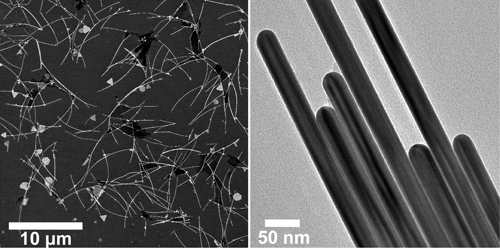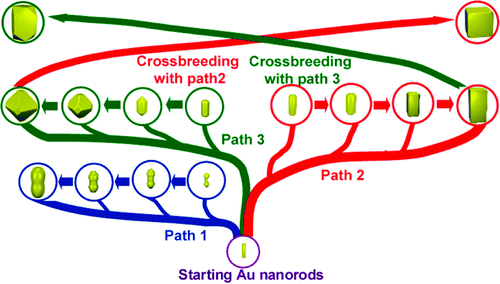Metal nanocrystals
In this area, we explore new synthetic capabilities to create plasmonic metal particles with desirable morphologies and surface structure, and develop scalable techniques to improve their manufacturing. Some examples are shown below.
Chemical synthesis of gold nanowires
High aspect ratio gold nanowires with single crystalline surface have long been a missing piece in the toolbox of plasmonics metal nanostructures. Such wires are now made with a room temperature, surfactant assisted chemical synthesis in acidic aqueous solution.

Gold nanowires
Construction of evolutionary tree for morphological engineering of nanoparticles
A morphological engineering approach has been created by constructing an evolutionary tree consisting of a few branches of independent growth pathways. Using gold nanoparticles as an example, it is demonstrated that each branch yields a string of evolving, continuously tunable morphologies from one reaction, therefore collectively producing a library of nanoparticles with minimal changes of reaction parameters. In addition, the tree also provides ground rules for designing new morphologies through crossing over different pathways.

An evolutionary tree of gold nanorods
Cross-flow purification of nanowires
Cross-flow filtration is shown to be an effective method to remove particle by-products from, for example, silver nanowires. To quantify the effect of purification, number- and weight-average aspect ratios and a polydispersity index (PDI) are defined, which borrow concepts of molecular weight distributions from polymer science.

Cross-flow purification of nanowires, and borrowing concepts from polymer science to characterize nanowires
Also see:
- ChemViews Magazine: Separating the (Nano)wheat from the (Nano)chaff
- Nature Nanotechnology – Research Highlights: Nanoparticle synthesis: Family gold
- Nanowerk-Spotlight: An evolutionary tree for nanotechnology particle engineering
- ACS Nano podcast: An interview with Prof. Huang, enhanced podcast with images